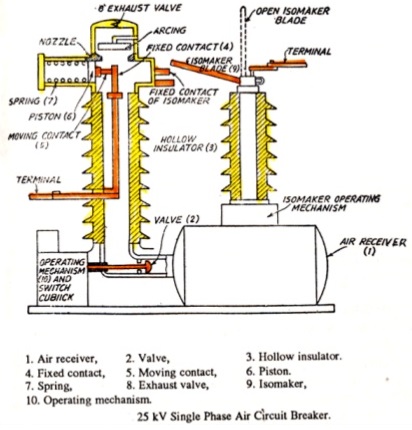A circuit breaker is a mechanical switching device, capable of making, carrying and breaking currents under normal circuit conditions. It is also capable of making and carrying currents for a specified time and breaking currents under specified abnormal circuit conditions, such as those of a short circuit. Air Blast Circuit Breaker is one of major component in medium to high voltage applications.
Operating Mechanism of Circuit Breaker
Circuit Breaker consists of two contacts i.e. fixed contact and moving contact. Moving contact is used to make and break the circuit using stored energies in the form of spring or compressed air. In this case the spring, pneumatic or oil damping is used to arrest the speed of moving contact while closing. Fixed contact contains a spring which holds the moving contact after closing.
Circuit breaker consists of two coils i.e. closing coil which is used to close the circuit and tripping coil that is used to trip the circuit. These coils activate the stored energy and directs the moving contact to open or close. DC batteries are used to energize these coils and solenoids are used to close or trip it. Circuit breakers are usually arranged with pilot devices to sense a fault current and to operate the trip opening mechanism.
Electric arc is produced during the separation of contacts, this happens due to large fault current and high current density at the contact region that ionizes the surrounding medium thus a conducting medium is formed. This phenomena is Arcing of a contact which is mainly due to potential difference between the contacts and ionized particles between the contacts. Air circuit breakers are very useful to avoid the arcing damages.
Air Blast Circuit Breaker
Air blast circuit breaker operates using high velocity blast of air which quenches the arc. It consists of blast valve , blast tube & contacts. Blast valve contains air at high pressure. Blast tube carries the air at high pressure & opens the moving contact attached to spring. Air should be kept clean & dry to operate it properly.
This type of breakers employ ‘air blast’ as the quenching medium. The contacts are opened by air blast produced by the opening of blast valve. The air blast cools the arc and sweeps away the arcing products to the atmosphere. This rapidly increases the dielectric strength of the medium between contacts and prevents from re-establishing the arc. This extinguishes the arc and interrupts the flow of current.
Types of Air Blast Circuit Breakers
- Axial-blast type: In which the air-blast is directing along the arc path
- Cross-blast type: In which the air-blast is directing at right angles to arc path
- Radial-blast type: In which the air-blast is directing radially
Construction of Air Blast Circuit Breaker
In air blast circuit breaker (also called compressed air circuit breaker) high pressure air is forced on the arc through a nozzle at the instant of contact separation. The ionized medium between the contacts is blown away by the blast of the air. After the arc extinction the chamber is filled with high pressure air, which prevents restrike. In some low capacity circuit breakers, the isolator is an integral part of the circuit breaker. The circuit breaker opens and immediately after that the isolator opens, to provide addition gap.
Advantages of Air Blast Circuit Breaker
- It eliminates the risk of fire.
- The arcing products are completely removable by blast.
- The growth of dielectric strength is so rapid that final contact gap needed for arc extinction is very small. This reduces the size of device.
- The arcing time is very small due to the rapid build up of dielectric strength between contacts.
- Due to lesser arc energy, ABCB are very suitable for conditions where frequent operation is applicable.
Disadvantages of ABCB
- Air has relatively inferior arc extinguishing properties.
- Air blast circuit breakers are very sensitive to the variation is the rate of re-striking voltage.
- Considerable maintenance for the compressor plant which supplies the air blast.
The air blast circuit breakers are useful for wide applications in high voltage installations. Majority of the circuit breakers for voltages beyond 110kV are of this type. In the near future, present interrupting technologies can be applied to circuit-breakers with the higher rated breaking currents (63kA to 80kA) required in some networks with increasing power generation.
Discover more from Electrical Engineering 123
Subscribe to get the latest posts to your email.

